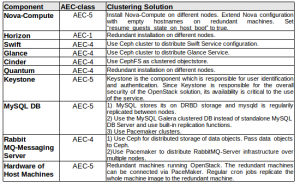As proposed in a former article different technologies must be evaluated in order to make the current MobileCloud environment suitable to High Availability (HA) requirements. The following article lists a basic evaluation of the different technologies that could be used.
Basically there are four technologies which allow to build a reliable HA-infrastructure for OpenStack:
- Build OpenStack on top of Corosync and use Pacemaker cluster resource manager to replicate cluster OpenStack services over multiple redundant nodes.
- For clustering of storage a DRBD block storage solution can be used. DRBD is a software that replicates block storage (hard disks etc.) over multiple nodes.
- Object storage services can be clustered via Ceph. Ceph is a clustered storage solution which is able to cluster not only block devices but also data objects and filesystems. Obviously Swift ObjectStore could be made highly available by using Ceph.
- OpenStack has MySQL as an underlying database system which is used to manage the different OpenStack Services. Instead of using a MySQL standalone database server one could use a MySQL Galera clustered database servers to make MySQL highly available too.
The different technologies have been evaluated according to their ability to make different OpenStack components highly available. The following table shows which technologies could be used to make the different OpenStack Services used in MobileCloud suitable to High Availability requirements.

It is obvious that the different technologies can be used in different architectural setups. It is obvious that they must be used in a multi-node OpenStack Architecture. An architecture proposal will follow up in a further article.